|
FAQs about Brittlestar
Identification 2
Related Articles: Brittlestars, Sea
Stars,
Related FAQs: Brittlestar ID 1, Brittlestar ID 3 & Green Brittlestars, Brittlestars 1, Brittlestars 2, Brittlestars 3, Brittlestar Behavior, Brittlestar Compatibility, Brittlestar Selection, Brittlestar Systems, Brittlestar Feeding, Brittlestar Reproduction, Brittlestar Disease, Seastar Selection, Seastar Compatibility, Seastar Systems, Seastar Feeding, Seastar Reproduction, Seastar Disease,
|
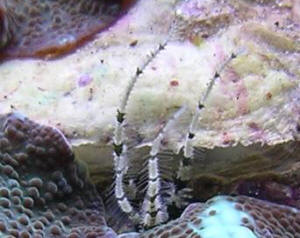
|
| Baby Mini Brittle Star? Nope, Hydroid Jellyfish!
8/19/07 I was wondering if this was a mini brittle star.
<Nope, it's a teeny tiny crawling hydromedusae (Staurocladia
oahuensis) and generally nothing to worry about. Please see these
links for photos and more information:
http://www.wetwebmedia.com/jellyidfaqs.htm
http://www.ronshimek.com/Animal%20Groups%203%20Cnidarians.htm
<Take care -Lynn> |
|
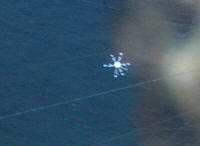
|
Brittle Star Fish Reproduction? Nope... Micro Brittle
Stars -- 08/01/07 <Greetings Mich here.> I have a brittle
star fish. <OK.> It lost about an inch of two legs a couple weeks
ago. <OK.> I saw them wiggling around, but then they disappeared.
<OK.> Now I am noticing at least 10 "baby" starfish
wiggling around in the crushed coral. I've questioned in the past
about the "starfish" attached to the glass (which are not
starfish at all). <Likely Asterina stars.> These are definitely
different. Their arms move around just like the momma star and they are
the exact proportion, but they are so small. Could they actually be
reproduced brittle starfish? <No. Most likely a different species
altogether. These are probably micro brittle stars (Ophiactis spp.),
beneficial scavengers. A fine addition to any marine tank. You can see
some photos here: http://www.wetwebmedia.com/brittlestaridfaqs.htm >
Why are there so many if only two legs broke off? <Are not one and
the same.> Thank you for your help! <Welcome! Mich>
Starfish ID... Striped Micro Brittle Stars
(Ophiactis spp.) 7/11/07 Hi all, <Hi there! Mich
here!> Recently I purchased a really nice looking piece of live
rock from my LFS who is very reputable and does very very good work
in the marine aquarium world. However, I got home and put it in my
tank, and after a little bit I noticed a lot of little legs
sticking out. The legs belong to some type of brittle star which I
hope is not the dreaded green brittle star. <Hee! No tis not the
dreaded green brittle star.> Of the ones I've seen, they
have 6 serpent-esque legs around a round disk which on the largest
one I saw, is no bigger than 1/2 an inch in diameter. The legs are
a banded in alternating brown and a grayish green pattern. I've
attached a pic which isn't the best, but it can hopefully give
you an idea of what I'm talking about. <Yes you can see a
better picture here on the query dated 04/01/2007.
http://www.wetwebmedia.com/brittlestaridfaqs.htm You have a Striped
Micro Brittle Stars (Ophiactis spp.). They often have 6 arms,
because they frequently reproduce by asexual fission. They are a
beneficial addition to your tank and are part of the clean up crew.
Hopefully they will reproduce and establish themselves in your
system.> Hope you can help me.
<Hope I did! Mich> |
|
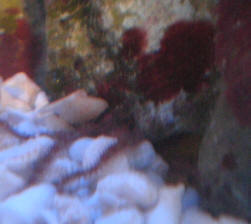
|
Ophiactis spp.? Perhaps, or maybe Ophiothrix --
07/07/07 Thought I would post this here for those of us that
are relatively new to the hobby. I feel I got a pretty good picture
of it and would mostly like to share the picture with you so that
new people to the hobby that find one would have a source here for
their identification. <Thank you for sharing and helping
others.> You can post this e-mail or not as you so choose as I
really don't have a question at this point <Most all get
posted.> unless I am wrong in my identification. <Is a micro
brittle star of some sorts, perhaps an Ophiothrix spp. as they tend
to live on sponges, gorgonians, corals.> My tank is a 29-gallon
Oceanic Bio Cube. It has been in operation since 07-Jan-07, so
almost 6 months old. <Welcome to the hobby.> I found this
last night, first time I had ever seen him/her. From what I can
find it is a Striped Mini Brittle Starfish (Ophiactis spp.) a
detritivore and good addition to any CUC. <Is a detritivore and
a beneficial addition to any marine tank. What is a CUC?> He is
about the size of a nickel from tip to tip. He is in this picture
resting on the main branch of a red Gorgonian with yellow polyps,
they are closed right now except the few that you see open on the
branch to the left, but when all are open what a beautiful
creature. <Yes, but not likely photosynthetic. I suspect it is
Diodogorgia nodulifera, which has a rather poor record of survival
in captivity. Requires good water flow to prevent algae growth,
which can smother and kill it. You will likely need to do
supplemental feedings with planktonic foods or finely minced frozen
foods. This is a high maintenance gorgonian.> TOO COOL!! I am
excited. Amazing the things that you find even after this amount of
time. <And what you will continue to find with sharp eye and
patience!> Best regards,
Henry G. Mello
<Thanks for sharing. Mich> |
|
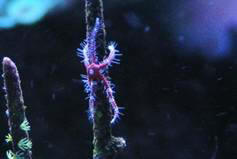
|
|
Re: hitchhiker... Micro Striped Brittle Star (Ophiactis spp.)
... -- 06/26/07 <Hi Matt, Mich with you tonight. I
included your previous email below. I saw this picture when you
sent it in earlier this month. Coming back for a third opinion I
guess...> I attached a photo. The feeder tentacles are
slightly out of focus but visible nevertheless. <I see.>
There are probably 6 to 10 of these critters that hide in very
small openings in the rock (I would say as small as a 1/4 inch).
<There are probably many more than what you observe.> The
tentacles are striped and reach out about a 1/2 inch (though one
of them reaches up to 3/4"). When they grab a piece of brine
shrimp they either curl it up and bring it in or sometimes it
seems that they have tiny legs on the tentacles that carry it
down the tentacle. <Yes, you will have a difficult time trying
to convince me this is anything other than a brittle star as
previously stated. I would be quite surprised if this is not a
Striped Micro Brittle star (Ophiactis spp). You can do a Google
image search using the term Ophiactis or you can see some picture
here: http://www.wetwebmedia.com/brittlestaridfaqs.htm Please do
take a look for yourself. You seem to need convincing. Ophiactis
are very small, generally get up to be about an inch across from
out stretched arm to outstretched arm, the body itself is
typically less than a quarter of an inch, thus the common name:
Micro Brittle star. They are common hitchhikers on live rock,
reproduce readily in most systems (many reproduce by asexual
fission and often have 6 legs instead of the classic 5 legs) and
are beneficial members of the clean up crew.> I caught a
glimpse of one time for a half of a second and it appeared to
look more like an insect and lacked a definite color. <There
are not many marine insects... of the 2 MILLION described species
of insects about 250-350 species are thought to be able survive
exposure to marine environments but there are NO known species
that remain submerged through out there lifecycle.> They also
seem to be most active during the day especially in the evening
around feeding time. I never see any indication of their presence
at night. <They usually stretch out there arms during the day,
(particularly around feeding time) as they can easily (I guess
this is a relative term...) regenerate an arm, but keep their
bodies with in the relative safety of the live rock. At night
they may venture about under the rocks, but you will generally
not observe out stretched arms at this time as they are more
secure under cover of darkness.> Thanks for your help. I hope
you have a couple ideas about what these things are. <Yes, I
am confident with the ID. Hopefully I have given you enough
information that you can check and determine for yourself that
the information provided is indeed on the mark. Edify thyself...
<<Amen. RMF>> Mich> Matt Hitchhiking Brittle
Stars - 6/15/07 <Hi Matt> I have searched for hours and
hours attempting to identify these critters I have living in my
rock. I just want to know what they are and what they look like.
I would guess that there are at least six of these guys hanging
out in tiny holes, some no bigger than a 1/4 inch in diameter, in
my rock. The only thing visible is two, half inch tentacles
reaching out. I actually saw one pop out for an instant after a
feeding of brine shrimp. It looked segmented like an insect but
it was so quick I cannot be certain. Can you help me identify
these critters? <I sure can! They're small brittle/serpent
stars, most likely a species that stays small (usually around an
inch or less across), and a neat addition to your tank. They
hitchhike in and like to hang out in crevices in, and around, the
rockwork. What you're seeing are several of their little
'arms' reaching out in hopes of catching a bit of food
floating past. Please see WWM for more information, starting
here: http://www.wetwebmedia.com/brittlestarreprofaqs.htm > I
attached a photo and I can also send a higher resolution copy if
needed. <Thanks, but I think we're good to go!> Thanks
Matt Huppert <You're very welcome! -Lynn> Re:
Hitchhiking Brittle Stars (Maybe not?!)- 6/15/07 <Hi
Again!> It is definitely not a brittle star. What is your
second guess? <Hmmm, sorry about that! If there's any way
you can get a good close up shot of one of these, that would be
terrific. Thanks. -Lynn><<RMF would swear this is an
Ophiuroid also>>
Re: Hitchhiker... Micro Striped Brittle Star
(Ophiactis spp.) - 06/27/07 Wow. <Hello again Matt,
Mich here.> Thanks, <Welcome!> I guess I just needed a
little more detail. <Yes. Sometimes our ideas/believes about
what we know/understand become fixed and we have a difficult time
accepting/comprehending anything that conflicts with these
concepts. Sometimes further evidence/explanation is required for
us to acknowledge/embrace the new information.> I guess what I
saw was something sharing the space with it and snagged the food
out from its tentacle. <Often this is the case.> I wonder
that the heck that thing was. <A Scud (Gammaridean amphipods
or Gammarus shrimp) would fit the general description you
provided... looks like an insect, color is... well... "Scud
color" as you said, "lacking a definite color" is
a good description. Hides in the live rock during the day as
another appropriate name for this creature would be "fish
food". You can see some pics here or again do a Google image
search: http://www.wetwebmedia.com/amphipodfaqs.htm
http://www.museum.vic.gov.au/crust/amphigal.html > Thanks for
the help.
<You are most welcome! Mich>
|
|
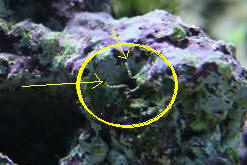 Same pic, same org. Same pic, same org.
|
| Ophiolepsis sp. (Serpent Star)
Reproduction...Nope Striped Micro Brittle Stars (Ophiactis
spp.) 4/1/07 Hi, <Hi Elaine, Mich with you
today.> I read your information frequently and have some photos
to share. I have attached two pictures of what I think
are baby Serpent Stars. <Mmm, nope
sorry. These are not babies, but a different species
altogether. They are Striped Micro Brittle Stars
(Ophiactis spp.). If you notice, at least 2 of the stars
in you photo have 6 arms. This is because they often
reproduce by asexual fission. They are a wonderful
addition to your tank and are part of the clean up
crew. They will likely reproduce and establish
themselves in your system.> I have two Ophiolepsis sp. serpent
stars in my 90 gallon tank as part of my clean-up
crew. I purchased a fish net breeder box to hold a ball
of macro algae in the overflow of the lower tank, which is where I
found the babies. I was doing some tank cleaning and was
going to change the netting on the breeder box. When I
looked into the box, the babies were hiding in the ball of
algae. I got them out and put them into a small tank
with a huge piece of live rock. They immediately hid in
the crevices of the rock. They came out to pose when I
changed some of the water in the small tank. I was
wondering what I should feed them. <They eat detritus.>
Thanks for the wealth of information that you have contributed!
<From Bob and the rest of the crew, you're quite
welcome. -Mich> Elaine |
|
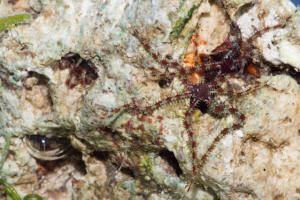
|
| Re: Ophiolepsis sp. (Serpent Star)
Reproduction...Nope Striped Micro Brittle Stars (Ophiactis
spp.) 4/1/07 Mich, <Elaine> Thanks for the
information - these are definitely cute little guys - and they
clean too! :) <Yes! All good! Enjoy
them! -Mich> Elaine |
Small Brittle Star 3/6/07 Hi,
<Hello.> great site thanks for all your advice in the past.
<Welcome.> I am attaching a picture I found on
another site....since I can't get a clear picture of
mine in my tank. I purchased a rock with
blue mushrooms and out of several holes I see
these three white-black banded arms sticking out at
times. They are always in threes and never
look like anything more than this picture which depicts
them beautifully. Any idea what this is.
<A small brittle star, nothing to worry about.>
Thanks again
Carlos
<Adam J.> |
|

|
Brittle or serpent star? Bristly -vs.-
Smooth. 2/25/07 Good evening! I cannot seem to find the
information on WWM or in the Reef Invertebrates book <See page
346> which tells the difference between Serpent Stars and Brittle
Stars. <Most serpent stars have smooth arms where as
most brittle stars have some type of spiny projections. More
here: http://www.wetwebmedia.com/ca/cav1i4/echinoderms/echinoderms.htm >
My FOWLR tank (45 gal, one Humu Humu Trigger, one Sailfin Tang, One
Tomato Clown and one Yellow Tail Damsel) has been running since
February 2006 and has had this collection of fish since the end of June
2006. <Sigh... Here come the tang
police... The sailfin tang will get big, to nearly 16
inches. Tank size should be a minimum of 135 gallons to
provide enough swimming space. Forty-five gallons is way too
small long term for this fish.> Everything seems happy
and healthy. <See above comment.> A few weeks ago I
saw a small star of some sort - center is about the size of an eraser
on a pencil, the five legs are each about 1-1.1/2"
long. It is a dark gray-green color. Legs appear
to be smooth. Is this a green brittle star? How
is a serpent star different? <I suspect you have some mini stars in
your system. Either Amphipholis or possibly
Ophiactis. Both are beneficial detritivores that need little
in terms of care and typical reproduce in the system. I
don't think there is any cause for concern.>
I've only seen this guy three times in the last few weeks, at night
after the lights have been out. <Not surprising, most hide during
the day.> Thanks! Judi <You're
welcome! -Mich>
| Invert ID Zoanthids <Maybe a
Chlorophyte> and Euryalid 02/17/07 Dear
Mr. Fenner, <Hi Laurie, Mich here.> I hope I am not going to
crash your server again! <Nope! Not this time!> I
have resized the pictures of the inverts. I hope you can id them
for me! <Will try, the photo are quite blurry. The
Macro setting on your camera (symbol often looks like a flower)
might help for future reference.> I do not know if you have
received the text--so, I'll write everything again.
<Actually saved the text before deleting the overwhelmingly
large photos. Included the original text at the end of
this message.> The group of green tubes began to grow around
November in my classroom 12 gal. tank. The largest is about 1 inch
long with a diameter of about 1/16 of an inch. The tubes are
turning white at the base and appear to have fine white
"hairs" on them. There appears to me a mouth also at the
end of the tube (I can see a dark green slit), although I have
never seen the mouth open. See photo of green tubes. <I believe
the photo shows a Zoanthid colony. Please read more
here: http://www.wetwebmedia.com/zoanthid.htm ><<This
looks like the Green Algae, Neomeris sp. to me. RMF>> The
second photo was taken of my gorgonian in my 55 gallon home
tank. The creature has been attached to the gorgonian
since I bought the gorgonian and is growing fast. Its
"arms" move, but it appears to stay in the same place
daily...a possible Euryalid?! <Could be, hard to tell by the
photo but the description and the behavior would
fit. RMF any comment?><<Maybe>> Thank you
for your help! <Welcome! -Mich> Laurie Price
<Mmm, Laurie... the pix aren't here... are you sure you
attached them? Please cc yourself (to make sure they're getting
through) and re-send. BobF> <Original text below.> I have
(possibly) two different types of inverts that I cannot id. myself.
One type is in my classroom's 12 gallon nano tank. There are
about 7-8 of them. They began growing last November. They are not
about 1 inch long with a diameter of about 1/16 of an inch. They
appear to have white "hairs/fuzz" on their bodies. See
photo of lime green tubes. The other creature is on my
gorgonian in my 55 gallon tank at home. It, too, is growing. It has
maroon skin and several arms. The arms have cream colored
"feathery" branches coming out of them. See photo of
purple gorgonian. Thanks for your help! Laurie Price, NPHS |
|
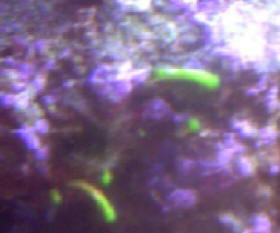 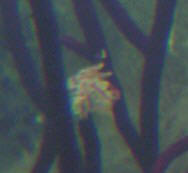
|
Brittle Stars in macro algae, Ophiactis spp.
1/23/07 Hello All - <Hi there Charlene, Mich with
you today.> I have an odd question. <Mmm, probably not that
odd...> I just purchased about a handful and half of macro algae
from a LFS. <OK.> I was going to put it in my 20 gal tank that I
house 6 dwarf seahorses and a mandarin. When I was getting ready to
open the bag I noticed something crawling back into the algae. I looked
closer and turned the bag around and I saw a couple of dozen brittle
stars in the bag. The size range goes from a little shy of a dime to
smaller than a tip of an eraser and that's just what I can see
without tearing the algae apart. I tried to take a picture of one of
the larger ones but, it just came out blurry and they move rather fast.
They are a light tan color with a dark brown spot as the center.
<Yes, these are Micro Brittle Stars, Ophiactis spp., beneficial reef
safe, clean up crew members. There are a couple of queries
regarding these on this page, be sure to note the size as the larger
one are a problem. http://www.wetwebmedia.com/brittlestaridfaqs.htm>
I am very concerned about adding these with my dwarfs. Could I leave
them in the refugium and be safe? I do not want to hurt them either.
<Refugium or display is fine. These stars stay small and
should reproduce in your tank, which, in my opinion would be a good
thing.> I have found conflicting advice where I have searched the
past couple of hours. <Yes, larger species are a concern, but these
little ones are a fine addition.> Thank you in advance for your
help. I appreciate it. <You are quite welcome! -Mich>
Charlene Pardi
| Brittle star id, worries -
1/18/07 Hi guys and gals, <Hey Scott, JustinN with you
today.> I've been burning the midnight oil trying to
ease/confirm my worries about my brittle star. Here's the
story: I bought a used 60 gallon tank 10 months ago, and I'm
still in the early stages of stocking and upgrading it, so that I
can eventually call it a reef tank. It came with an ocellaris
clown, yellow damsel, royal Gramma, a sea cucumber, and a brittle
star (and lots of live rock). In the last couple months I added a
neon goby, yellow streak fairy wrasse, and flame angel. The flame
angel hid in the rockwork immediately, and I only saw glimpses of
him for the first two days, after which I didn't see him at all
for another 4 days. I took most of the live rock out to try to find
him, and found that the brittle star had obviously eaten him.
<Mmm...> I know it's possible/likely that he
died first from the stress of shipping or disease (my girlfriend
bought him as a surprise gift without really knowing what to look
for--an innocent but probably costly mistake) <And I hope you
explained to her the rationale and reasoning for conscientiousness
as an aquarist...> but now I'm concerned that the brittle
star could be predatory. <Mmm, all too likely> I
figured he was safe because he's not the infamous green brittle
star your site warns about, but further investigation (endless
google image searching) makes me think he might be in the same
genus, Ophiarachna. <I would agree with this> The closest
resemblance I've seen is a picture on marinedepotlive.com of a
"bubble tip brittle 'fancy' sea star, Ophiarachna
sp." Any idea from the blurry pics? He's definitely big
enough to pose a threat to my small fishes (~14 in. diameter with
about a 1.3 in. body). <Yes, quite large... definitely a
predatory threat. Although, I'm not too hip on specific
identifications, so I can't help you any further than I have
here, perhaps RMF will chime in here?> I'm worried to the
point of wanting to give him away, but I do like his scavenging
ability and would want to replace him with another detritivore (a
"safe" echinoderm?). <Do consider so-called serpent
stars for this task.> Or, would he be okay if I transferred him
to the refugium/sump? It's a 20 gallon with a large skimmer and
pump, some live rock, and Chaetomorpha algae, alternating light
cycle with the main tank. Any help at all would be appreciated.
<Mmm, too likely that the echinoderm will consume any beneficial
benthic life in the refuge.> On another topic I might as well
bring up, my Gramma has become much more shy over the last 2
months, only darting out to eat and hiding again. He's been
with the same tankmates for the last 5 months (and the damsel for 2
years) and his hiding constantly is pretty new. He looks perfectly
healthy to me. Do you think the damsel is intimidating him? I
haven't seen any overt hostility. It actually seems like
he's also scared of me. Do you think giving away the damsel
would make him more comfortable? <Its possible that the damsel
is causing some aggression you're not noticing, however this
seems to be a fairly common behavior for royal grammas. I
wouldn't be too overtly concerned here.> Sorry for the long
email and thanks for a great website. Scott <No problems, Scott,
the details help us. Hope I've helped you! -JustinN> |
|
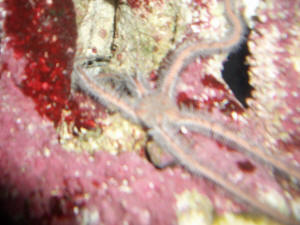
|
Snake stars... name 1/16/07 Hi
<Hello there> I hope you can help me, I have some confusion as to
what snake stars actually are as the phrase is used some what
flippantly! Are snake stars another name for all Brittle stars? Are
snake stars another name for all serpent stars? <This common name is
used interchangeably for a few species of Ophiuroids..> Or are snake
stars separate species from a family of Brittle stars? I appreciate
your help. Thanks very much Janet <I would say all Snake Star
species are Brittlestars, but not all Brittlestars are referred to as
Snake Stars... sort of like all newts are salamanders, but not all
salamanders are newts. Bob Fenner>
Deadly green brittle star?!?
1/6/07 Mr.. Fenner, Attached is an e-mail that I have tried to
send to WWM for about two months now. I understand that ya'll
are having server issues and just want to make sure it is not on my
end, Thanks, Brandon <Hotay... hope it clears through my acct.
B> Deadly green brittle star?!? Resend of a prior unanswered
e-mail. Thanks, Brandon Hello crew! So , I sent my wife
to the store to get a "clean up crew" for her 55 Gallon
Reef tank. She came back with a few blue and red hermits, a few
turbo snails, a few Chromis (she thought they were cute) and this
brittle star. Looks to me like the fish killer AKA Green brittle
star. <And there are more fish-eating Ophiuroids than
Ophiarachna...> The guy at the LFS did not warn her that this
bad boy might turn her favorite Royal Gramma into a midnight snack.
As you can see in the pics, her punishment was having to hold the
star long enough for me to take MANY pictures. Am I IDing this
wrong or is this her new refugium clean up buddy never to touch her
main tank?!? <Is likely O. incrassata> Her system has a 10
gallon fuge with a wet dry. If we put him in the fuge will he get
enough food (nothing is in the fuge yet except pumps and heaters
since we are waiting for the right macroalgae to get into stock)?
<Should be fine food-wise, yes> On a side note, We were
wondering why WWW has never had a LFS good bad list. <Mmmm> A
place where people can write reviews on the LFS and other WWW
readers can sort out the good, the bad and the ugly! <We allow
postings of individual assessments... but do think on this...
Who's to judge? There is at least a tint of
collaboration/agreement in such... Many foreigners believe all U.S.
citizens are in accord with the Bush Administration... and, who
knows when particular staff, management, practices may change and a
"bad" store/governance, become "better to
good?"> Thanks for all the wonderful information you
provide! Brandon
<Thank you for sharing. Bob Fenner> |
|
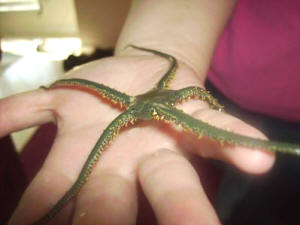
|
Small brittle stars? 12/28/06 Hello,
<Hi there, Mich with you tonight.> found your website today while
trying to research what appears to be quite a few brittle stars I found
hitch hiking in on live rock and while I haven't yet been able to
find anything to answer my question the information included in these
posting is very interesting and informative. <Glad you
think so!> Now my question, recently decided to set up a new reef
tank in my office and when I put in the first few pieces of live rock
I've seen literally a dozen or more small animals that appear to be
brittle stars. Unfortunately I cannot take pictures of them
but will do my best to describe so that you may be able to narrow down
the species. These all have a central disk of dark grey or
brown about centimeter across with six arms, some seem to have lost a
few and are regenerating, that are banded in white and the same color
as the disk. Closer examination with a magnifying glass
shows that the arms have small hairs or spines along the entire
length. They all move just like any other brittle stars that
I have seen, and move in and out of the rocks, across the glass and
across the substrate. It's the six arms and they all
have them, that has me confused. I did some research and
found a picture of Ophiocoma Alexandri (Alexander's Brittle Star)
here http://www.wetwebmedia.com/brittlestars.htm like the one's
I'm attempting to describe, although I'm not sure if I'm
seeing six legs or five and a shadow on this picture. Any
ideas? And if you think this is not said brittle star what
do you think it is, I've read most are good for reef tanks but that
there are some exceptions. I think these are interesting,
should I leave them alone? <Sounds like a striped micro brittle star
(Ophiactis sp.). A good friend indeed and a beneficial part
of your clean-up crew. They should happily reproduce in our
tank and often do so by asexual fission, basically splitting in half
and regenerating the missing half. This is often why they
are often observed to have 6 arms instead of the more common
five.> Thanks, <Welcome! -Mich> Todd
Camp
Re: small brittle stars (Ophiactis savignyi)
12/28/06 <Hello Todd, Mich with you again.> Many
thanks again!! <You are quite welcome!> After your
reply I was able to do some more research and believe I have narrowed
these individuals down to Ophiactis Savignyi. Just in case
anyone else has these and is interested: <Oh! Thank you
for sharing!> Ophiactis savignyi (Muller and Troschel, 842)
Identification -- Small (2 cm diameter with arms) 6-armed brittle
star. Green, brown or cream. Distribution -- Tropical and
subtropical eastern Pacific, Indo-Pacific and
Atlantic. Common in all reef habitats. Notes -- Can be
extraordinarily abundant, often lives in sponges. Reproduction includes
asexual fission and sexual development with a feeing larva. http://striweb.si.edu/publications/PDFs/Collin%20et%20al. Page
698. <Muchas gracias! -Mich>
|
|

